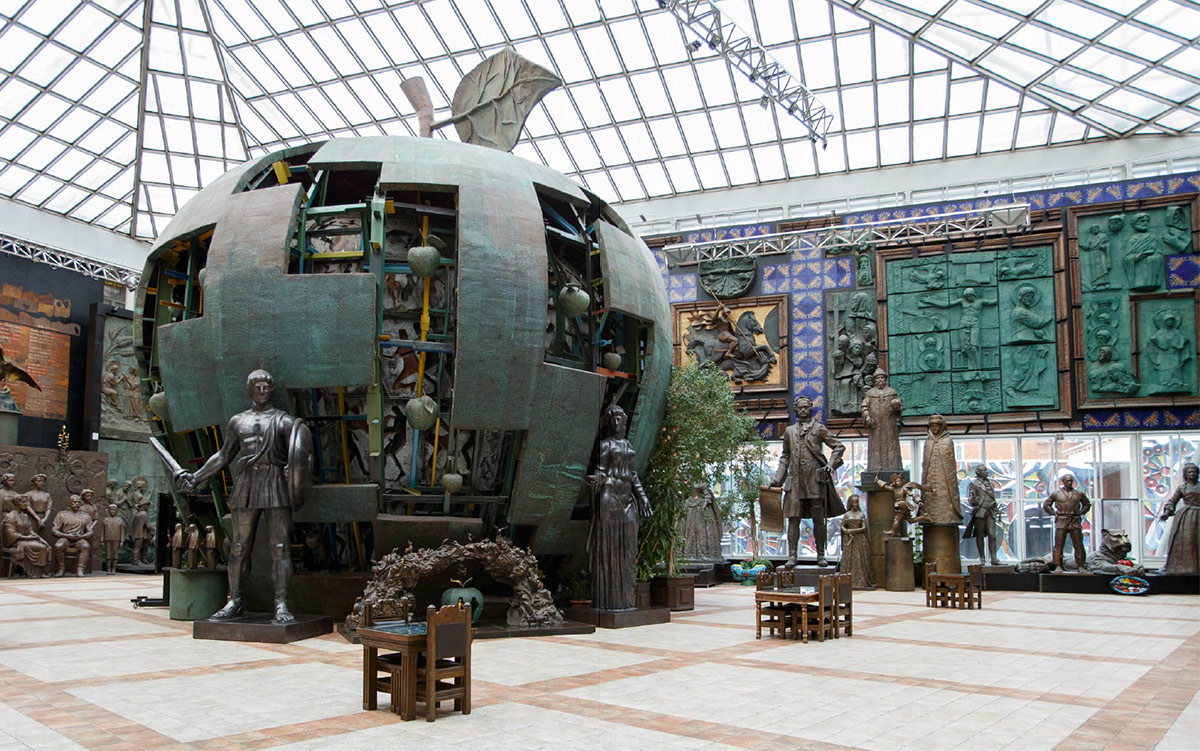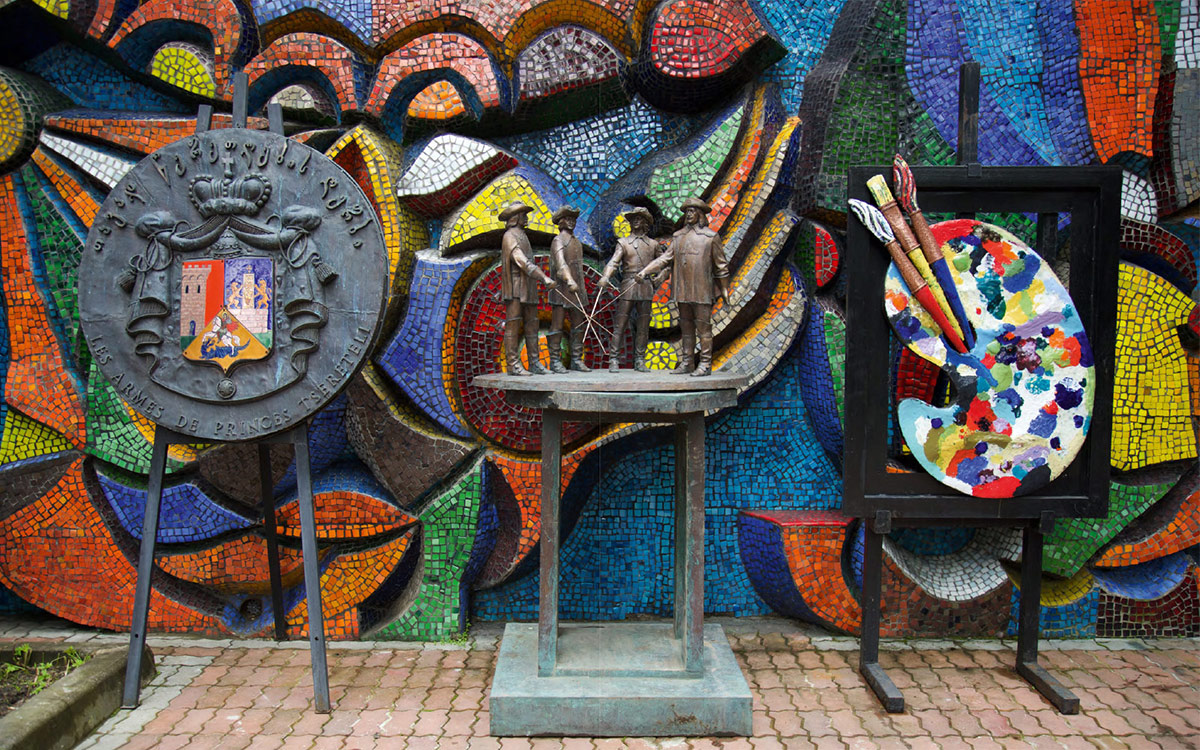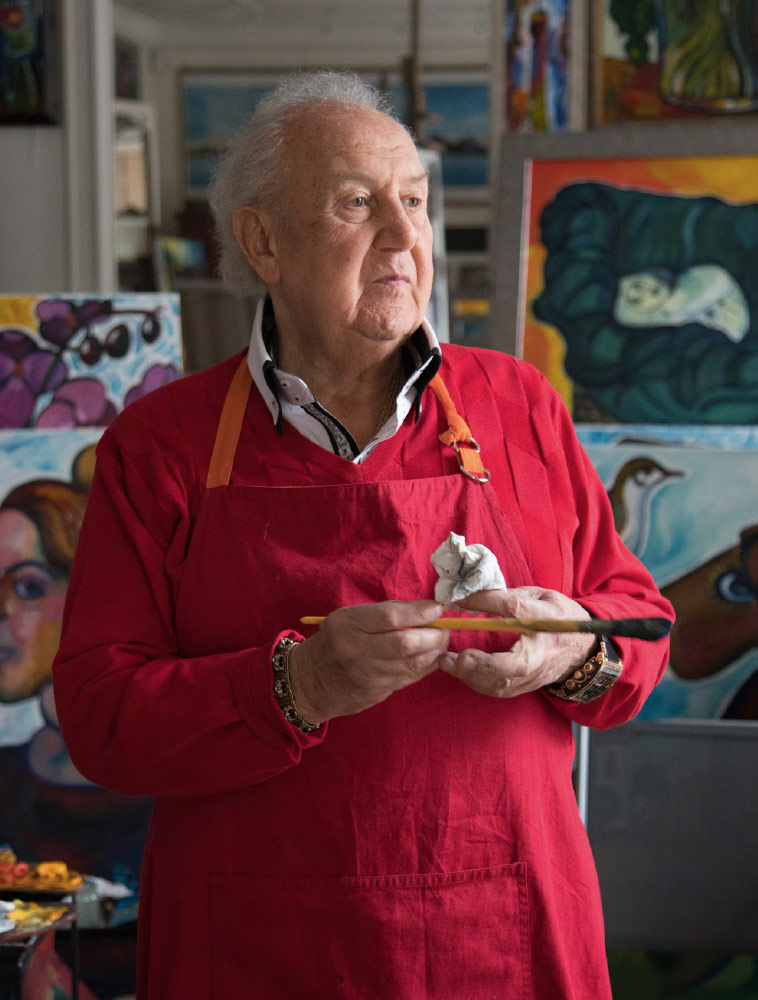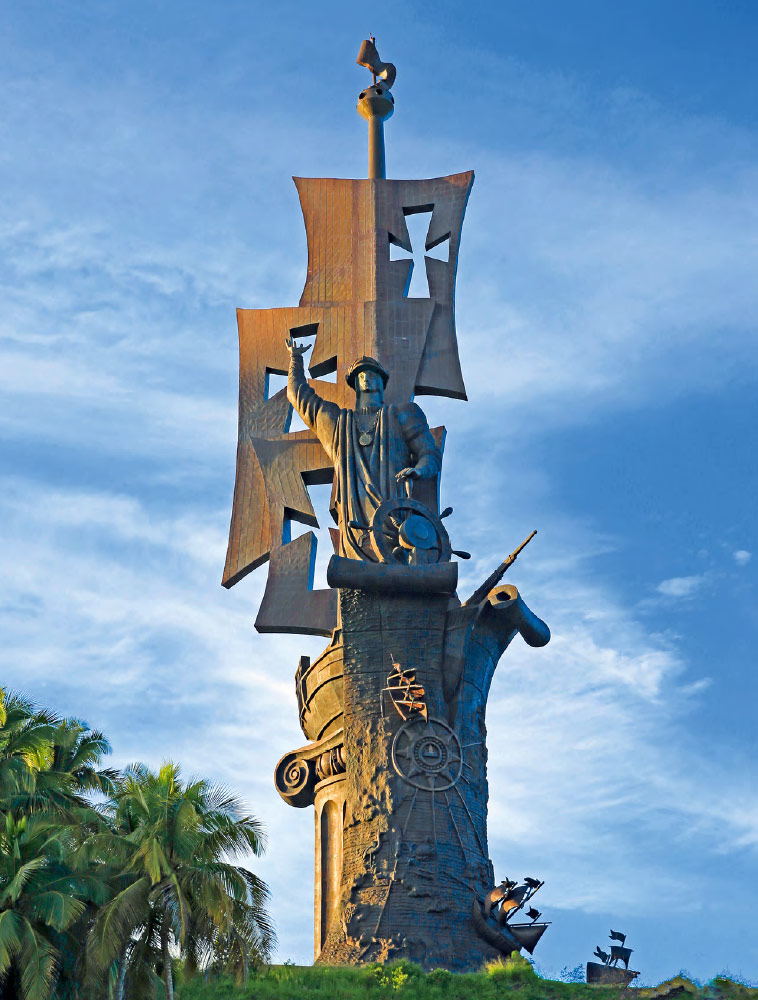The Charisma of Zurab Tsereteli
“The man of genius is he and he alone who finds such joy in his art that he will work at it come hell or high water.”
Stendhal
The present century and the one preceding it have subsumed the greatest achievements and discoveries of world history. From the time of the Enlightenment to the present day, modern civilisation has made an incomparable spiritual contribution to global artistic culture. For all the wealth of national talents, each people has its own talismanic figures who embody the traditions of their ethnic group. However, on the level of wider humanity, it is rare to find figures who are outside their time, creed and ethnicity. Irrespective of aesthetic preferences, breadth of view or level of education, personalities on such a scale are defined by a combination of both their creative and social activity.

“Apple” Hall in Zurab Tsereteli Art Gallery, Museum and Exhibition Complex of the Russian. Academy of Arts, Moscow. Photograph

Zurab Tsereteli House Museum. Peredelkino, Moscow Region. Photograph
The ambivalence with which the art of Zurab Tsereteli has been received is but a confirmation of his fate to belong to this small cohort of great masters of the 20th and 21st centuries. He is a carrier of traditions from various eras and peoples and the proud bearer of the name of an ancient princely lineage, who has inherited from his ancestors nobility and magnanimity, honour and charity.

In the Studio. Paris. Photo: S. Shagulashvili
Tsereteli found his way in art at a young age, largely thanks to his parents and their circle. Georgii Nizharadze, the brother of Tsereteli’s mother, Tamara Zurabovna, was an artist at whose home great figures of Georgian art were regular guests, among them David Kakabadze, Lado Gudiashvili, Apollon Kutateladze and Ucha Japaridze. These were the men who foretold the creative future in store for the young Zurab. Setting eyes on the first, early works of the gifted child, these authoritative masters sensed in him a rare capacity for perceiving the world in vivid, graphic terms. Thanks to these early acquaintances and a sensitive attitude, Zurab was able to enrol at the Academy, in those days home to a shining array of artists. We will mention the well-known names of the Russian masters who worked there alongside Japaridze and Kutateladze: Eugene Lanceray, Iosif Charlemagne and Vasily Shukayev. And so, Tsereteli’s cherished dream of becoming an artist came true. Konstantin Ivanovich, an engineer by training who had supposed that his son would follow in his own footsteps, came to take pride in Zurab’s successes - he cut out and collected clippings from newspapers and magazines with reviews and articles about his son. Indeed, his parents, despite their extremely limited resources, did everything that they possibly could to support Zurab. In those postwar years, they, like most families in our country, lived in difficult conditions, not to mention the fact that Tamara’s father had been arrested and shot in 1937, when the young Zurab was barely three years old. Konstantin and Tamara named their son in his memory. Despite the hardships and irreplaceable loss that the young boy suffered, his heart did not harden - he, just like his family and those closest to him, believed in life and looked to the future with an optimism that is entirely characteristic.
At the Academy, Tsereteli stood out from his classmates thanks to his natural gift, tireless work ethic and thirst for creativity. The artist’s original style and unique character were formed by his dedication, inner awareness of novelty and his ability to accumulate diverse feelings and ideas. As early as the 1960s, his art was receiving attention from such significant figures of 20th-century art as Pablo Picasso and Marc Chagall. That attention only speeded up the realisation on the part of those surrounding him that his was a unique personality, capable of thinking on a particularly grand scale and capable of anticipating and foreshadowing the future. He is well within his rights to say of himself, using the words of Isaac Newton: “If I have seen further, it is by standing on the shoulders of giants.” For him, the embodiment of such giants (colossi) are Leonardo and Michelangelo, Columbus and Peter the Great, Picasso and Salvador Dali.
Tsereteli is able to solve complex figurative problems in both monumental sculpture and small-scale forms because he is a producer of ideas and a maximalist in whose art are combined - in the most unexpected ways - classical traditions and the latest artistic discoveries. His artworks are conglomerates of feelings and thoughts that are not easily pigeonholed into the canons of particular stylistic trends and tendencies, but rather astonish one with the width of their creative range, thematic ambiguity and the associative expressiveness of their graphic language.
Tsereteli’s pieces are instantly and unmistakeably recognisable - they are like tuning forks of the times. Take, for instance, the monument “Good Defeats Evil” by the UN building in New York, the sculptural-architectural composition “Birth of a New Man” on the 500th anniversary of Columbus’s voyage to America (Seville, Spain), the monumental composition “Tear of Grief” in memory of the victims of the 9/11 attacks in New York (New Jersey, USA), the memorial “To the Children of Beslan” (Moscow, Russia), or the monument “Russkaya Pravda” (“Chronicle of Rus”) (Kogalym, Russia).

Birth of a New Man. Sculptural-architectural composition dedicated to 500th anniversary of Columbus’s voyage to the New World. Installed in Puerto Rico in 2016
Stainless steel, bronze. Height 126 m
We recognise and feel the far-reaching depth of figurative thoughts and fantastic ideas of the master when we cast our eyes upon his work - the monumental ensembles, the paintings and drawings, the architectural and design projects and the sculptural compositions as well as those in enamel and stained glass. He never, in fact, repeats himself, and is constantly renewing and perfecting his arsenal of technical tools, materials and techniques. You can see this with your own eyes when you examine works such as the architectural-sculptural complex “Chronicle of Georgia”, located on the outskirts of Tbilisi, which strikes one with the ritual character of its spirituality; the memorial constructed on Moscow’s Poklonnaya Hill in honor of the victory of the Soviet People in the Great Patriotic War of 1941-1945; in the vestibule and two aisles of the Moscow Metro station Park Pobedy, with its two panels executed in coloured enamel, which symbolically embody the martial achievements of our forefathers in the Patriotic War of 1812 and our fathers, grandfathers and great-grandfathers, who by standing up for peace, saved humanity from Fascism in the Second World War.
The well-known art historian Viktor Vanslov wrote of the master: “Tsereteli’s work attracts the viewer with its highly unusual treatment of the blooming cultural heritage, the scope and character of the interpretation of images, and their originality - an individuality of artistic vision. The artist’s oeuvre includes several remakes, which compel the viewer to re-evaluate some well- known works, as well as events reflected in them.” (The Tretyakov Gallery Magazine, #2 2006 (11), p. 101.)

From the “Jerusalem” series. 2005
Oil on canvas
Speaking of the artist’s “remakes”, the author was largely referring to the transformations, the rethinkings of narrative, semantic and substantive sources that go back to the Old and New Testaments. The most vivid expression of this multi-faceted side of Tsereteli’s art are his reliefs on biblical themes and the paintings he created during his visits to the Holy Land - to Jerusalem, Nazareth and Bethlehem. On this subject, Vanslov wrote: “But this is not just remembrance of things he saw. In Tsereteli’s vision, this is a past directed at the present and the future. The episodes and individuals that the artist captured at the Wailing Wall in Jerusalem represent timeless images, condensed into majestic symbols and marked with their sharpness of movement and emotional expressiveness - images that symbolise the age-old collisions of the struggle for Faith. They have an inner passion and a rich evocativeness and philosophical significance that is hard to describe in words.” (The Tretyakov Gallery Magazine, #2 2006 (11), pp. 100-101.)
The narratives of Holy Scripture are inexhaustible, and they form an integral and important part of Tsereteli’s entire creative oeuvre, insofar as, for him, the artistic incarnation of texts, semantic motifs and visual sensations is an activity almost sacred or liturgical in its nature. It is possible that precisely such a penetration of the emotional and substantive context of the concrete and universal models and situations captured by the temperamental brush of the artist gifts his paintings with their astounding monumentality, the syncretic scale of the real and the imagined. In this sense, his canvases resonate with images from Aleksander Deyneka’s Roman series. The past moves organically into the present, transformed into a sort of river of time, a “Book of Genesis”. The religious motivation of much of Tsereteli’s work is invisibly present in each and every one of his paintings, sculptural compositions, enamels, mosaics, stained glasses, watercolours and drawings. In their independence from any single type or genre, the materials and techniques used to create his pieces are filled with a divine light as if from within. Religion, as one of the eternal constants, defines our relation to human and humanistic values. The artist’s relation to his national history and the history of Russia is apparent in the grandiose complex “The Chronicle of Georgia” and in his work on the recreation of the Church of Christ the Saviour, a project for which Tsereteli was a direct participant and the artistic leader.
Passing over confessional boundaries, we will touch upon yet another landmark work of the master - the statue of Pope John Paul II which stands by Notre-Dame Cathedral in Paris (France). In the words of one of our most authoritative art historians, Dmitry Shvidkovsky: “The new monument by Zurab Tsereteli near Notre-Dame Cathedral in Paris is further proof of such a tradition that has turned the city into the artistic capital of the world. What is particularly striking is the perfect way the new sculpture fits within the famous architectural ensemble and its surroundings.
It is a location where the spirit of the Middle Ages still speaks to us. In his poem “Notre-Dame”, Osip Mandelstam described the feelings that it evoked in him: “A primal labyrinth, a wood past men’s understanding, / The Gothic spirit’s rational abyss, /Brute strength of Egypt and Christian meekness, / Thin reed beside oak, the plumb line everywhere king”’ (The Tretyakov Gallery Magazine, #2 2015 (47), p. 131.)
By quoting that great Russian poet, Shvidkovsky arranges very accurately the accents that largely characterise Tsereteli’s gigantic work. Just like Charles Baudelaire, Guillaume Apollinaire, Jacques Prevert, Camille Pissarro, Bernard Buffet, Raoul Dufy, Konstantin Korovin, Natalia Goncharova, Mikhail Larionov, Tahir Salahov, Ilya Ehrenburg, Ernest Hemingway and Pablo Picasso, Tsereteli cherishes his own Paris, and yet, for him, the Eiffel Tower remains the main landmark and symbol of the capital of France. In terms of its pictorial narrative, concept and colour scheme, this work of Tsereteli brings to mind Chagall’s mural decorating the ceiling of the Opera national de Paris. Just like the mural of Chagall, Tsereteli’s painting features a wide assortment of images of those whom the artist holds in great esteem: as if before the mind’s eye, rise the great men of culture surrounded by different personages and motifs alluding to the great spiritual heritage of the past. This painting is a pictorial hymn to the “movable feast”, a symphony that is articulated and brought alive by the polyphony of colour.
In the face of the maestro’s polyphonic palette, one is sometimes wrong-footed, although the feeling is more often one of amazement and disarmament before the sincerity of the spiritual outburst. The extravaganza of colour, the elemental power of the paints, the tension of rhythms and forms all tie in with the temperament and inner will of the mattre, with his optimistic world view and aesthetic ideals.
It is essential to note that Tsereteli’s main heroes and characters are present in all of his paintings, graphic sheets, enamels and sculptural compositions. They feature in both real-world pieces and in narratives born of the artist’s irrepressible fantasy. For the viewer, this serves as a mediated reminder of the monumental images, including those drawn from biblical narratives, that are present in the artist’s historical-allegorical cycles.
Note also the many portraits created by Tsereteli over the course of the past few decades. Among these, his portraits of Charlie Chaplin and Pablo Picasso, Niko Pirosmani and Henri Rousseau all stand out thanks to their emotional expressiveness. Each one is a richly populated composition cast in bronze, in which the artist’s imagination brought together like-minded people and cultural figures of different aesthetic tastes. For example, the wonderfully designed and executed sculptural portrait of Picasso, incorporating colourful accents, was a revelation for many critics and fans of Tsereteli. The master has always been surrounded by bright, remarkable and artistic personalities who are spiritually close to him thanks to their innovative dedication, world view and creativity, all of which represent for Tsereteli synonyms of true talent. The artist has immortalised his friends and fellow thinkers in a cycle of sculptural compositions. We can name but a few of them, all wonderful contemporaries of ours, to give a deeper understanding of his aesthetic and moral references: Vladimir Vysotsky, Joseph Brodsky, Andrei Voznesensky, Bella Akhmadulina, Andrei Dementyev and Ilya Reznik. This circle also includes great artists, musicians and directors: Boris Yefimov, Tahir Salahov, Boris Messerer, Dmitry Shostakovich, Mstislav Rostropovich, Mark Zakharov and Nikita Mikhalkov. Whether directly or indirectly, Tsereteli impulsively and openly expresses his feelings to these outstanding figures of our times. He always incorporates, in these matchless characterisations, personal intonations and features drawn from life, which are intrinsic to himself. Such it was that, having made the acquaintance of the poet Joseph Brodsky just before his departure (or rather exile) from the USSR, Tsereteli continued to remember and cherish him for his greatness, freedom and honesty. Over the course of many years, the artist anonymously helped Brodsky’s mother, who remained in Leningrad, and then immortalised the poet - already a Nobel laureate in the field of literature - in a sculptural composition. That sculpture forms part of a cycle dedicated to the geniuses and conscience of Russia. In the works just mentioned, it is worth noting the character and level of artistic synthesis, the fundamentally original scheme devised for three-dimensional figures, which remind one of both an architectural portal and a frame reflecting the treatment of the subject. They represent a large-scale composition in which the subjects are depicted from different perspectives, thanks to which there is an impression of an inner and unseen movement that is subject to change, depending on the angle from which the viewer is looking. The result is voluminous figures of full height with carefully decorated sculptural surfaces, in which the polished and textured elements combine to create a particular interplay of light. The cycle is at once faithful in terms of portraiture, and romantically or dramatically elevated. The artist endows his subjects with psychological traits that are characteristic of them personally, as well as the collective traits of a creative personality. For all the individuality of the imagery of each representation in bronze of figures from our national culture, these images also contain the spiritual and ethical qualities that connect the artist internally with his civic positions and deeds, as well as his moral and aesthetic principles and opinions.
The master’s delight in the multicoloured nature and contrasts of the world around him is reflected in the paintings of bouquets of flowers that emerge from under his temperamental and unfettered brush. His still lifes remind one of an outburst of unexpected and joyful emotion or a sincere confession. They express a limitless wealth of emotional nuances and possess a special attraction insofar as the live vibrations of texture and full-voiced harmony of colour inspire individual impressions and associations in each and every viewer.
Tsereteli often paints several canvases at the same time using a single bouquet of flowers as a subject, explaining this particularity of vision by changes of light and bursts of mood, which afford his authentic works a magical attraction provided by shades of feeling and meaning. Who would have thought that there could be a link between bouquets of flowers and a philosophical, metaphorical and meditative perception of multi-faceted reality? This is one of the inexplicable mysteries that are part of the magic of Tsereteli’s art. It is part of the process by which he gives space to the untroubled consciousness of the viewer in order for it to enter into an unspoken dialogue with the artist, drawn into the act of co-creation.
Tsereteli has a “sniper’s eye” — he accomplishes most of his paintings in one sitting, although he never takes breaks, creating images that persuasively convey his sitters’ character and sharply grasp their emotional and psychological state. His art combines lyrical romanticism and raw sensuality. These qualities of Tsereteli’s art are variously reflected both in the portraits and the genre and narrative pieces, landscapes and still lifes.
A driven person, Tsereteli never rests on his laurels: he is keen on unusual angles and compositions, forever experimenting and opening up new horizons for the art of the future.
Tsereteli’s emotional and all-embracing character is apparent in literally all that he does, but most vividly so in art and, above all, in his painting. Painting is, in fact, his passion and true element; when practising it, he belongs only to himself. In painting, the artist’s irrepressible energy finds an escape suited to his temperament. The bright colours on the wide palette never have time to dry out and the blank canvases piled by the easel are nearly instantaneously filled with the colour of life and time. It is of no importance to Tsereteli whether he is painting a landscape or a still life, a portrait or genre composition - he paints both the real and imaginary world, and each finished work, whatever its genre, becomes a “selfportrait” reflecting the artist’s inner state, his thoughts and feelings. With every change in the light, the maestro removes the canvas he has been working on from the easel and replaces it with a fresh one. The colouring, tonali ty, nuances, the rhythm of the paintbrush and texture of the surface - everything changes, and along with a new mood come new thoughts and dreams.
He is a great experimentalist, who astounded both the Mexican monumental sculptor and muralist David Alfaro Siqueiros and the Brazilian architect Oscar Niemeyer.
Tsereteli has at his command both his experience of combining painterly surfaces in two and three dimensions and his discovery of new expressive and decorative possibilities of enamel relief. He has a respectful attitude to the preservation and development of tradition and is keenly aware, sympathetic to and firm in his defence of the achievements and principles of our national and academic artistic education. At the same time, Tsereteli is an advocate of evolutionary progress in art, along with the use and incorporation of multimedia technologies and innovations. The initiative for the foundation of the first museum of modern art and contemporary styles in Russia belongs to him. Indeed, he has made a substantial contribution to the construction of museums and their cause in general. One of his latest acts was the foundation of the museum in Peredelkino, but aid to regional museums has always been and remains a daily concern. This is far from the whole extent of the selfless activities of the master, among which one of the most significant is his struggle to strengthen and develop the art educational system despite the best efforts of dilettante reformers. The artist’s long-standing dream of creating an institute of performing arts is also taking shape thanks to his indefatigable energy and persistence. All this bears witness to the worldwide vision of Tsereteli, to his participation in forming the aesthetic, moral and philosophical views of the next generation who will, in the future, inherit our civilisation.
Among Tsereteli’s favourite and most respected figures from the history of global art are Niko Pirosmani, Paul Cezanne, Amedeo Modigliani and, undoubtedly, Pablo Picasso, Marc Chagall and Jean Tinguely. Their colouristic notes and intonations often echo in Tsereteli's own painting as a reminder of the heights of professional culture and inspiration that they reached. The immense and intriguing world of images created by Tsereteli is a creative, unremitting and romantic hymn to life and all that it contains, a rich and multi-layered gamut of feelings and colours.
Zurab Tsereteli, who is also a Hero of Socialist Labour, has headed the Russian Academy of Arts for nearly a quarter of a century. Indeed, over the entire course of Russia's Soviet and Post-Soviet history, he has proven himself to be an individual capable of statesmanship, creative dedication, all-encompassing organisational gifts and exceptional human talent, as a master and leader, whose name deservedly enjoys international authority - he is a UNESCO Goodwill Ambassador, a member of the most prestigious academies of art in the world, including those of France (Institut de France) and Spain, and a professor who has carried out his pedagogical activities over many years.
Tsereteli has preserved and nurtured the great traditions of the Russian Imperial Academy of Arts and defended its independent status.
Photograph
Photograph
Photograph
Wool, weaving
Wool, weaving
Oil on canvas. 150 × 100 cm
Oil on canvas. 150 × 200 cm
From the series “I Was Born a Gardener”. Oil on canvas. 160 × 120 cm
From the series “I Was Born a Gardener”. Oil on canvas. 170 × 130 cm
Bronze. Height 3.8 m
Bronze. Height 2.5 m
Oil on canvas
Oil on canvas
Oil on canvas
Enamel. 50 × 70 cm
Bulk enamel
Oil on canvas. 100 × 100 cm
Head. Coloured plaster
Zurab Tsereteli House Museum in Peredelkino, Moscow Region
Photograph
Oil on canvas
Enamel
Multi-part sculptural composition. Bronze, hot enamel. Height 2.40 m. Exhibited in the “Apple” Hall of Zurab Tsereteli Art Gallery, Museum and Exhibition Complex of the Russian Academy of Arts, Moscow
Multi-part sculptural composition. Bronze, hot enamel. Height 2.40 m. Exhibited in the “Apple” Hall of Zurab Tsereteli Art Gallery, Museum and Exhibition Complex of the Russian Academy of Arts, Moscow
Sculpture. Bronze. Height 2.20 m. Installed in 2018 near the building of the Russian Academy of Arts, Moscow
Sculpture. Bronze. Height 2.20 m. Installed in 2018 near the building of the Russian Academy of Arts, Moscow






































